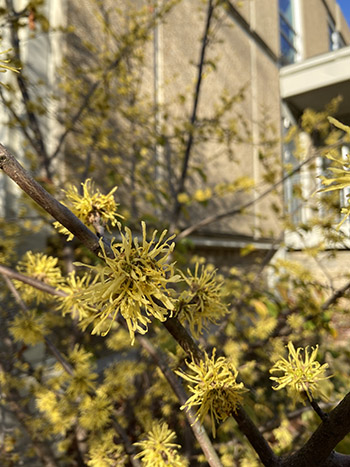
Polygonatum odoratum ‘Red Legs’ – Solomon’s seal
There is, rightfully so, much excitement for the blooms and color of spring and summer. The scent of lilacs, the sight of little tulips popping their heads above ground, the bees churning around the monarda; it is all a lively delight. But when the leaves have all fallen, the bulbs long gone to sleep, and the bugs having burrowed, I find another round of joy in seeing what plants produce seasonal interest past spring and summer. This year my interest has been snagged on solomon’s seals and in particular Polygonatum odoratum ‘Red Legs’ which can be found in the Harry Wood Garden.
There are approximately 63 species of Polygonatum, each having rhizomes and alternate leaves carried on upright to arching stems. Flowers are produced at the leaf axils (where the leaf meets the stem) and a small black fruit develops in late summer. Come fall, the color drains from the leaves, leaving white to tan tissue-paper foliage, casting a ghost-like appearance in the garden. During this time, some species of Solomon’s seal wither and flop over fast, while others remain upright, displaying their berry set and hallowed foliage atop tall stems. Of all my wanderings in the Scott Arboretum during this time of year, the cultivar ‘Red Legs’ has proven to be the most impressive with the passing of time, creating great interest beyond the bloom.

Actaea pachypoda – white baneberry
Actaea pachypoda and its vivid red-pink stalks adorned with porcelain-like berries offers a unique, yet ominous-looking, presence in the garden. Perhaps the form follows function and the bizarre-looking nature of these seeds projects to viewers a warning about the toxicity of this plant.
The berries of Actaea pachypoda contain cardiogenic toxins, which can have an immediate sedative effect on cardiac muscle tissue, resulting in serious illness or death. But prior to the berries, the white baneberry produces a handsome flush of foliage, with frothy white flower spikes floating above. It is a fantastic plant for shade, is an eastern U.S. native, and is a food source for birds, who are immune to the toxic effects. Find this striking plant in the Isabelle Cosby Courtyard.

Hamamelis virginiana ‘Harvest Moon’ – common witchhazel
The Harvest Moon relates to the timing of the Autumn Equinox, with the full moon that occurs nearest to the Equinox being the one deemed Harvest Moon. This means the Harvest Moon can either be in September or October depending on how the lunar cycles line up with the calendar. So, it only seems fitting that the star witchhazel of the fall season would be Hamamelis virginiana ‘Harvest Moon’.
Developed by noted Connecticut Kalmia expert Richard Jaynes of Broken Arrow Nursery, this common witchhazel selection has considerably larger and showier flowers than the straight species. And, most importantly, it is assured to bloom after the leaves have fallen. That’s right folks, no holding onto brown leaves for this Hamamelis, this one blooms on bare stems! Like the species, with adequate room, this specimen will grow into a medium sized tree with an attractive vase shape and blooms in late fall. See this impeccable bloomer in the rear of the Science Center along Whittier Place.
